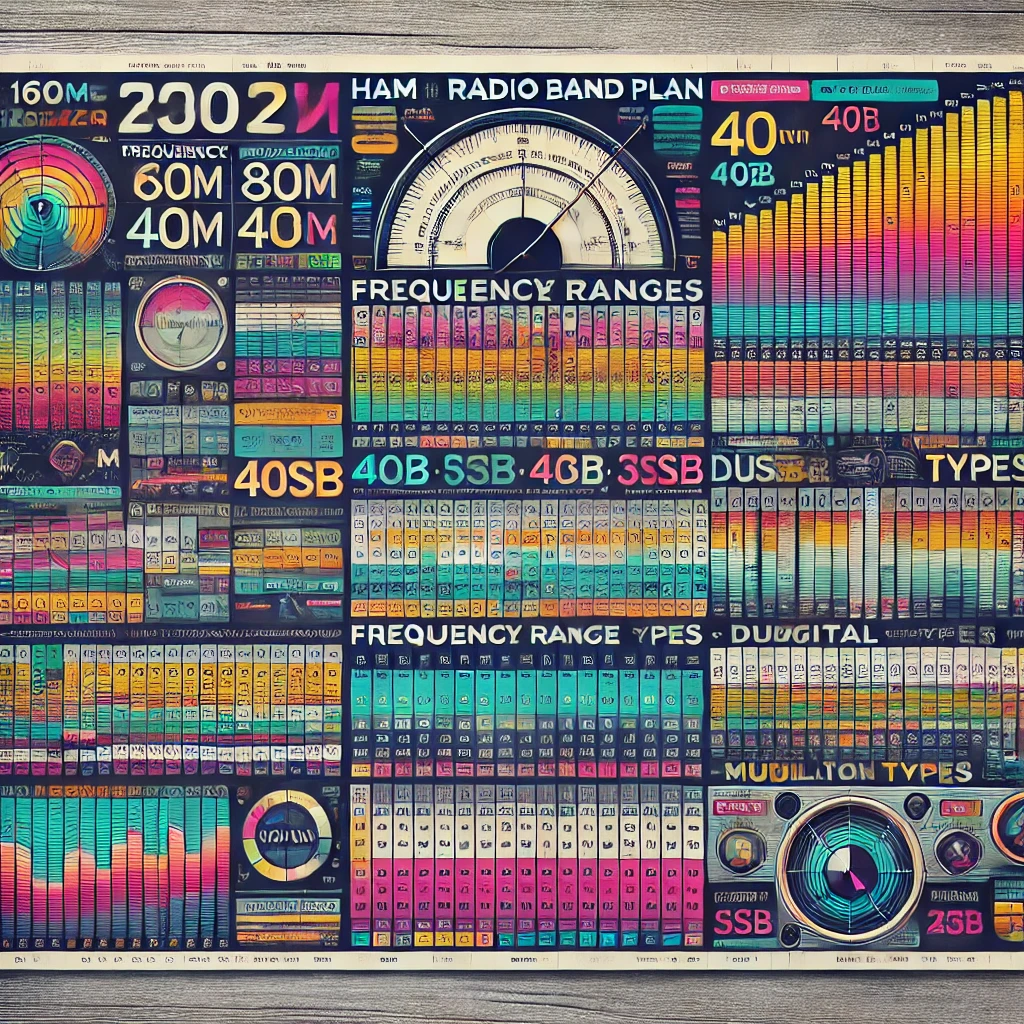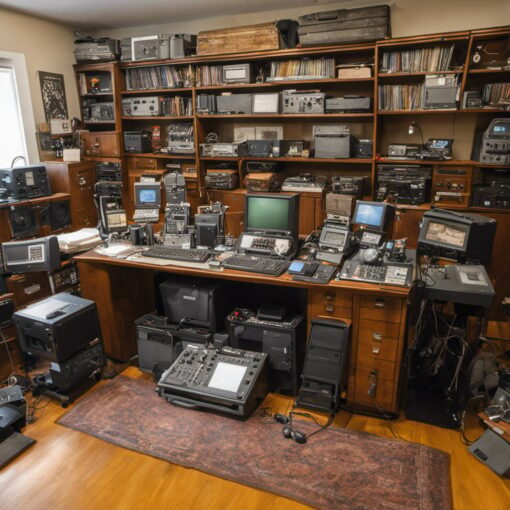Understanding ham radio band plans is essential for anyone interested in amateur radio. These plans outline the specific frequency ranges that operators can use, helping to avoid interference and ensuring smooth communication.
By knowing where to operate, amateur radio enthusiasts can connect better with others and enhance their overall experience.

The spectrum for ham radio is divided into various bands, each with its rules and modes of operation.
From VHF/UHF to HF bands, each range offers unique opportunities for communication.
Understanding these differences allows operators to choose the right band for their needs, whether they want to engage in local conversations or reach out to distant stations.
Key Takeaways
- Ham radio band plans define specific frequencies to prevent interference.
- Knowledge of band usage enhances communication capabilities.
- Operators can leverage advanced techniques to improve their experiences.
Understanding the Ham Radio Spectrum
The ham radio spectrum is a vital resource for amateur radio operators. It consists of various frequency allocations regulated by the FCC, creating specific band plans that help ensure effective communication and compliance with regulations.
Frequency Allocations and the FCC
The Federal Communications Commission (FCC) manages the frequency allocations for amateur radio in the United States.
They designate which frequency ranges can be used for various communications and ensure that amateur operators adhere to these rules.
Frequency allocations help prevent interference between different radio services.
The FCC divides the spectrum into bands, each assigned for specific uses, including ham radio.
Understanding these frequencies is crucial for operators as they navigate through different communications.
Band Plan Basics
A band plan serves as a guide for operating within specific frequencies allocated for amateur radio.
It provides information on the appropriate usage of different bands, including voice, data, and digital communications.
Each band plan is tailored to various license levels, from Technician to Extra class.
These plans outline specific frequency segments that operators should use to reduce interference and stay compliant with regulations.
This structure promotes efficient communication and gives operators the tools to avoid conflicts while using the spectrum effectively.
Ham Bands Overview
Ham bands refer to designated segments of the radio spectrum intended for amateur radio. Each band has unique characteristics, such as propagation behavior, range, and conditions for operation.
For example, the Low Frequency (LF) Band ranges from 30 kHz to 300 kHz.
The High Frequency (HF) Band spans 3 MHz to 30 MHz, often used for long-distance communication.
Meanwhile, the Very High Frequency (VHF) and Ultra High Frequency (UHF) bands cover ranges from 30 MHz to 300 MHz and 300 MHz to 3 GHz, respectively.
Familiarity with these bands allows operators to choose the best frequencies for their needs, enhancing their overall ham radio experience.
Operating Modes and Band Usage

Understanding the different operating modes and how they fit within the ham radio band plan is essential for effective communication.
Each mode has its advantages and covers specific frequencies, allowing operators to choose the best approach for their needs.
Phone and CW Operations
Phone operations primarily utilize Single Sideband (SSB) and Amplitude Modulation (AM).
SSB is more popular due to its efficiency and ability to maintain clearer signals over long distances. This mode is commonly used on HF bands, including 20 meters and 40 meters.
In contrast, Continuous Wave (CW) operations use a simple on-off keying method to send Morse code.
This mode is effective for long-distance communication, especially when conditions are poor. CW signals can often be heard even when voice signals are garbled or inaudible.
Digital Modes and Related Technologies
Digital modes have become increasingly popular among ham radio operators.
These modes use computer software to encode and decode signals.
Common digital modes include RTTY (Radio Teletype) and SSTV (Slow Scan Television).
These modes often occupy specific frequency ranges within the HF bands. For instance, RTTY typically operates around 14.070 MHz while SSTV usually occupies 14.230 MHz.
Digital modes allow for reliable communication, often under challenging conditions, and can be more effective than voice modes when signals are weak.
Mixed-Mode and Experimental Operations
Mixed-mode operations combine various communication styles, allowing users to switch between modes like SSB, CW, and digital. This flexibility is advantageous during contests or when band conditions fluctuate.
Experimental modes are also an exciting area for operators interested in pushing boundaries.
They can include methods like new digital encoding techniques and advanced transmission modes.
These experiments often operate outside traditional band plans, allowing for innovative communication solutions.
VHF/UHF Band Plans
VHF and UHF bands are essential for amateur radio operators. Understanding the specific frequencies and operational practices in these bands helps ensure effective communication and avoids interference.
2 Meters and 70 Centimeters Bands
The 2 meter band, which ranges from 144 to 148 MHz, is one of the most popular bands for amateur radio. The national calling frequency is set at 146.520 MHz.
Operators primarily use FM simplex modes for conversations.
Repeater systems are widely utilized in this band.
Repeater inputs typically occur between 144.00 and 146.00 MHz, while outputs range from 146.00 to 148.00 MHz.
These systems enhance communication distance and reliability, especially in urban environments.
The 70 centimeter band spans from 420 to 450 MHz. This band also hosts many repeaters, with input frequencies usually between 420.00 and 430.00 MHz.
Outputs are found from 440.00 to 450.00 MHz. Operators appreciate this band for its ability to support various modes, including digital and television.
1.25 Meters and 33 Centimeters Bands
The 1.25 meter band, from 219 to 220 MHz, offers a unique frequency allocation for ham operators. It is less congested than the 2 meter band, providing more space for weak signal and experimental work.
In this band, FM simplex, repeaters, and weak signal operations are common. While it may lack the popularity of lower VHF bands, it still offers a good range for local communications.
The 33 centimeter band ranges from 902 to 928 MHz. This band is known for its flexibility, supporting a variety of communication modes.
Repeater outputs in the 33 centimeter band generally occupy the range of 927 MHz. Inputs typically start from 902 MHz.
This allows for dynamic communication options, including point-to-point operations.
HF Band Plans
HF band plans are crucial for amateur radio operators, helping them navigate the various frequency bands effectively. They provide guidelines on which modes and frequencies are best suited for different types of communication.
160 Meters to 10 Meters Bands
The HF bands range from 160 meters to 10 meters and have distinct characteristics.
- 160 Meters (1.8 – 2.0 MHz): Known as the “Top Band,” it is primarily used for nighttime communication. This band is great for long-distance contacts but can be challenging due to noise.
- 80 Meters (3.5 – 4.0 MHz): This band is popular for local and regional communication, especially at night. It supports voice, CW, and digital modes.
- 40 Meters (7.0 – 7.3 MHz): A versatile band suitable for both daytime and nighttime. It is widely used for SSB (Single Side Band) and CW communications.
- 20 Meters (14.0 – 14.35 MHz): Excellent for long-distance contacts during the day. This band supports many digital modes and is known for its reliability across different conditions.
- 17 Meters (18.068 – 18.168 MHz): This band offers good long-distance communication, especially during sunspot peaks.
- 15 Meters (21.0 – 21.45 MHz): Active during the day, this band is good for DX (distance) operations.
- 12 Meters (24.89 – 24.99 MHz) and 10 Meters (28.0 – 29.7 MHz): Both bands are used for open communication when propagation conditions are favorable.
60 Meters and 30 Meters Bands
The 60 meters band (5 MHz) offers unique opportunities for amateur communication.
- 60 Meters (5.332 – 5.405 MHz): This band has only a few channels and is shared with other services. It allows for a mix of voice and data modes. Operators must follow specific power limits and usage rules to avoid interference.
- 30 Meters (10.100 – 10.150 MHz): This band is dedicated solely to CW and data modes, with no voice communication allowed.
It is popular for those interested in digital modes like PSK31 and RTTY. The 30-meter band offers excellent propagation characteristics and can be used during various conditions.
Advanced Communication Techniques
Amateur radio operators can utilize various advanced communication techniques to enhance their abilities. These methods improve connectivity and allow for unique broadcasts and signals. Understanding how to effectively implement these techniques is crucial for successful communication in the ham radio community.
Weak-Signal Communication and EME
Weak-signal communication involves making contact with distant stations despite low signal strength.
Techniques such as differential phase-shift keying (DPSK) and frequency-shift keying (FSK) play key roles in this area.
Operators may also use Earth-Moon-Earth (EME) communication, where signals are transmitted to the Moon and bounced back to Earth.
This method requires specific conditions for optimal results, such as a stable dish antenna and sensitive receiving equipment.
Operators often utilize specific propagation beacons to find suitable paths and improve signal ratios.
Many also use computer software to aid in signal decoding and processing.
Satellite and Space Communication
Satellite communication allows amateur operators to connect using satellites that relay signals back to Earth.
This form of communication is vital for reaching remote areas where direct connections are difficult.
Operators must understand satellite downlinks and uplinks to successfully communicate.
Using satellites like the International Space Station (ISS) can be a rewarding experience.
It requires knowledge about tracking satellites and employing suitable antennas.
Many operators participate in scheduled passes to maximize communication potential.
The use of digital modes can enhance signal clarity during these transmissions.
Amateur Television (ATV) and Fast-Scan TV
Amateur Television (ATV) enables the transmission of video signals and adds a visual element to amateur radio.
This form of communication uses different bandwidths, typically occupying the 430-440 MHz VHF band for video transmission. Operators need to comply with local regulations for frequency usage.
Fast-Scan TV (FS-TV) is a popular technique in amateur television, allowing for real-time video transmission.
It typically operates with a frame rate of 30 frames per second.
Operators rely on strong equipment and specific setups, such as analog or digital modulation techniques, to ensure quality broadcasts.
Practical Aspects of Ham Radio
Ham radio offers various practical applications. These include utilizing repeaters for communication and playing a vital role in emergency services. Understanding these aspects can enhance one’s skills and experiences in amateur radio.
Repeater Use and Etiquette
Repeaters are essential tools in ham radio. They allow operators to communicate over greater distances. Repeaters work by receiving a signal on one frequency and retransmitting it on another.
When using a repeater, it’s important to adhere to proper etiquette. This includes identifying with your call sign at appropriate intervals, waiting for a clear channel, and avoiding excessive chatter.
Operators should also familiarize themselves with local repeater frequencies and their associated timeouts. This helps to prevent interference. For additional communication options, beacons can send out continuous signals. They provide information about frequency usage and conditions.
QRP and Field Operations
QRP refers to low-power operation in ham radio, typically below 5 watts. This practice encourages operators to enhance their skills by maximizing efficiency and technique. It’s especially useful during field operations where power sources may be limited.
Operators can set up portable stations using battery power or solar panels. Using simple equipment, such as a QRP transceiver, allows for effective communication even in remote locations.
Field operations often involve a variety of modes, including SSB and CW. Many operators enjoy the challenge of contacting stations with minimal power while out in nature. This promotes a sense of achievement and adventure.
Emergency and Public Service
Ham radio plays a crucial role in emergency communications. Operators often assist in disaster relief efforts by providing vital communication links when traditional systems fail.
Training and preparedness are important for these situations. Many clubs offer courses to help operators understand emergency protocols and procedures.
Public service applications include supporting local events and community activities, such as marathons and fairs. Operators provide communication support for safety and coordination. Resources like packet radio can offer reliable data transmission during emergencies. This showcases the importance of ham radio in public safety.
Licensing and Operating Privileges
Understanding licensing and operating privileges is essential for anyone interested in amateur radio. The different license classes determine the frequencies and modes a person can use while operating.
US License Classes
In the United States, amateur radio operators can obtain different license classes. The Technician Class is the entry-level license. It allows operators to use certain frequencies above 30 MHz and some segments below that.
The General Class license grants expanded privileges, including access to more HF bands. Finally, the Amateur Extra is the highest level, offering the most extensive access to frequencies.
Each class requires passing specific exams. These tests cover knowledge of regulations, operating practices, and technical skills.
Frequencies and Privileges
The frequencies available to operators vary by license class. For the Technician License, operators mainly access the 2 meter band, from 144.1 to 148.0 MHz. This band is popular and useful for local communications.
The General Class operator can access additional bands, including sections of the 15, 20, and 40 meter bands. These bands cover HF frequencies ideal for long-distance communication.
Amateur Extra licensees can operate on all amateur bands. They have access to all the frequencies and are allowed to use advanced modes of communication.
It is important to follow the rules and band plans that govern these frequencies. This ensures effective communication within the amateur radio community.
Accessories and Supporting Technology
This section covers essential accessories and technologies that enhance ham radio operations. It includes key elements like antennas, propagation concerns, and necessary station equipment that help ensure effective communication.
Antennas and Propagation
Antennas play a critical role in ham radio communication. They capture and transmit radio waves effectively, significantly influencing signal quality. Common types include dipole, vertical, and beam antennas, each with unique properties suitable for different bands and propagation conditions.
Propagation refers to how radio waves travel and can vary based on factors like time of day and atmospheric conditions. Understanding these dynamics helps operators choose the right frequencies.
For instance, higher frequencies perform better during the day, while lower frequencies are more effective at night. Using tools like propagation prediction software can guide operators in selecting optimal times and frequencies for communication.
Station Equipment and Setup
Proper station equipment is vital for reliable ham radio operation. Key components include transceivers, power supplies, and antennas, along with accessories like microphones and headsets for clarity during conversations. Selecting a good-quality transceiver enhances functionality across different bands.
Setup also requires consideration of the operating environment. This includes ensuring adequate grounding, proper cable management, and sufficient ventilation for equipment longevity.
Operators often incorporate tools like autopatch and phone patch systems to connect their radios to phone lines, expanding their communication options. Investing in quality station equipment leads to better performance and a more enjoyable ham radio experience.
Frequently Asked Questions
This section addresses common queries related to ham radio band plans. Each question provides clarity on specific aspects of frequency usage and available resources for amateur radio operators.
What are the changes to the ARRL Band Plan in 2024?
In 2024, there may be updates to the ARRL Band Plan. These updates aim to improve efficiency and reduce interference among different modes. Operators should check the latest information from the ARRL to stay informed about any specific changes that affect their operations.
How can I obtain a free version of the ham radio band plan?
Amateur radio operators can find a free version of the ham radio band plan available online. The ARRL website often provides downloadable PDFs, which users can access easily without any cost.
What is the best resource for understanding the frequencies allocated for different ham radio bands?
The ARRL frequently serves as the best resource for understanding frequency allocations. Their band plans detail which modes are permitted on each band and are widely respected in the amateur radio community.
Where can I find an up-to-date printable ham radio frequency chart?
An up-to-date printable ham radio frequency chart can be found on various ham radio websites. Many amateur radio clubs and the ARRL offer these charts for easy printing.
What are the FCC’s regulations on amateur radio frequency usage?
The FCC establishes regulations that govern amateur radio frequency usage. These rules ensure proper operation within allocated bands and maintain order among different operators on the airwaves.
Are there any new amateur radio bands or mode changes I should be aware of?
Operators should stay updated on any new amateur radio bands or mode changes. Resources like the ARRL provide announcements about these developments.





